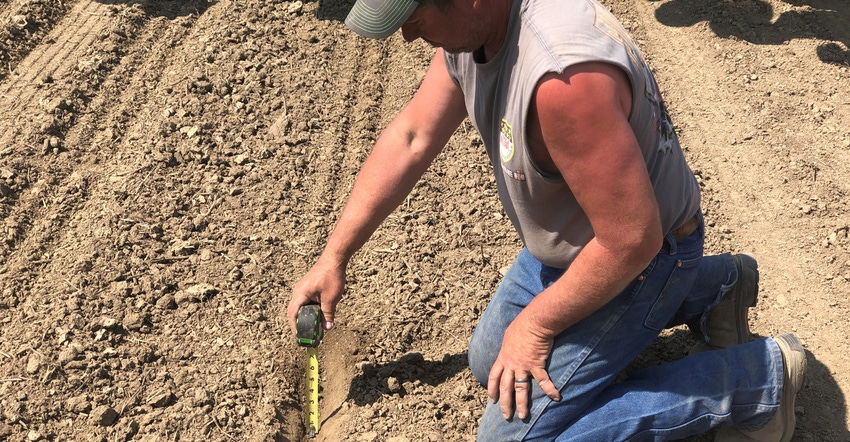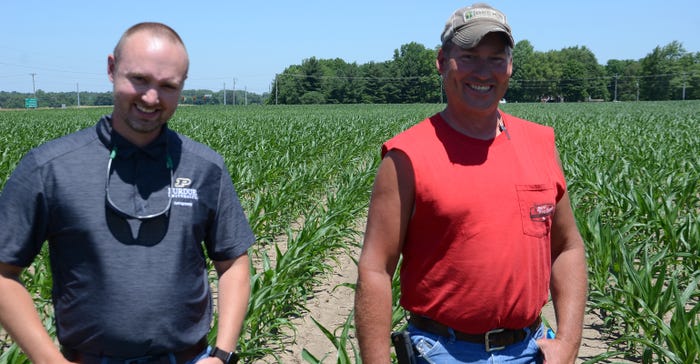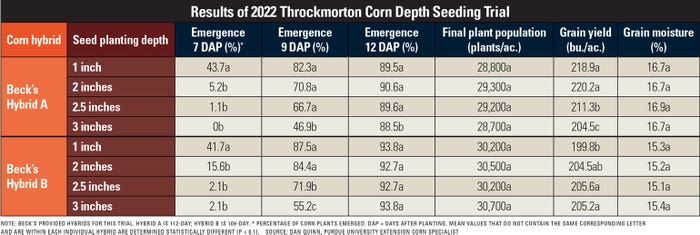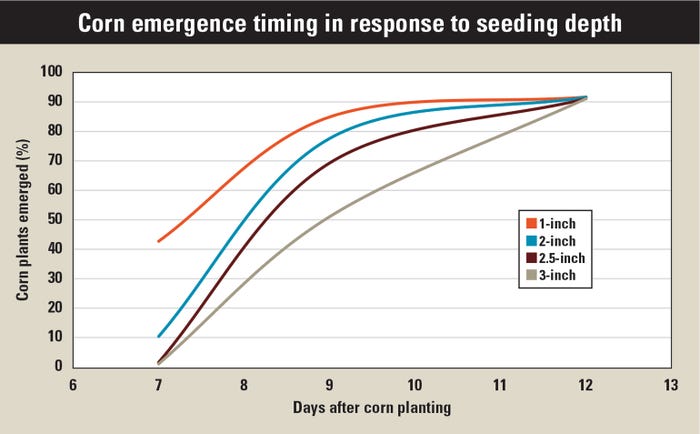January 3, 2023

During the heat of planting, it’s easy to forget to thoroughly check and understand two items. First, what seed depth am I planting at? Second, is my seeding depth consistent, especially across all individual row units?
You may be inclined to use the “set it and forget it” approach to seeding depth, yet this may not be the best idea. To get corn started off on the right foot, it is important to achieve both rapid and consistent emergence following planting.
One aspect of achieving rapid and consistent plant emergence is choosing the correct seeding depth, and ensuring there is adequate and uniform moisture at that depth. The most common seeding depth recommended for corn is between 1.5 and 2 inches, and these depths can work very well within most conditions. However, certain soil moisture conditions at planting may warrant further examination and perhaps a change in seeding depth.
Why seed depth matters
A corn seed imbibes soil moisture within the first 24 to 48 hours after planting. So, maintaining both adequate and uniform moisture at seeding depth within the first 48 hours is important. If the soil remains too dry, seed may be delayed in emergence until precipitation occurs. Conversely, if the soil remains saturated after planting, seed may rot and die.
If soil conditions are dry at planting, a seeding depth of 2 inches may be too shallow. It may not place seed in adequate, uniform soil moisture conditions. Therefore, if the moisture at a 3-inch depth is more adequate and uniform, and no additional rainfall is expected in the next week, it may be worthwhile planting seed 3 inches deep vs. 2 inches deep.

Remember that corn can physically emerge at seeding depths lower than 2 inches. When necessary, planting deeper can help ensure more consistent emergence. However, if soil moisture conditions are adequate, it is likely ideal to not go much deeper than 2 to 2.25 inches. If planted too deep and soil moisture conditions are adequate, emergence can become delayed. This exposes corn seed to various stresses like insects and disease organisms for more time. Furthermore, if corn is planted too shallow, say less than 1.5 inches, you run the risk of poor root development, poor stand establishment and lodging.
Comparing seeding depths
To further examine the impact of seeding depth on corn emergence and yield, a research trial was established at the Throckmorton Purdue Agricultural Center in Lafayette, Ind. The research trial examined corn seedling emergence timing and yield differences across four different seeding depths and two different hybrids. The trial was designed as a randomized complete block design with three replications. Plots measured 30 feet wide by 400 feet long in 12, 30-inch corn rows. The center six rows were harvested with a commercial combine with a calibrated yield monitor.
Purdue University, TPAC and Indiana Prairie Farmer cooperated to make this trial possible. Beck’s provided hybrids.
This research trial was planted on May 13. It received a total 1.75 inches of rainfall within the first two days following planting, measured at TPAC. This may have pushed the seed deeper and successfully supplied adequate moisture following planting.
However, the month of June was very dry, with a total precipitation of only 0.6 inch of rainfall, which may have contributed to some lost yield potential. Conditions continued to be drier than normal in July too.
Across all seeding rates examined, Hybrid A, a 112-day hybrid, outyielded Hybrid B, a 109-day hybrid, by an average of 10 bushels per acre, at 214 vs. 204. See the table for full details.

Results by seeding depth
In addition, across both hybrids, the seeding depth of 1 inch resulted in the fastest emergence, averaging 42% emerged seven days after planting, whereas the 3-inch depth resulted in the slowest emergence, averaging 1% emerged seven days after planting.
Despite the difference in emergence timing, final emergence percentage and final plant stand were not different between the two hybrids or the four seeding depths examined. Note that these results were analyzed using statistical methods common to trials where the same treatments are repeated several times. It’s interesting that the two different hybrids varied in yield responses to seeding depth. Hybrid A had the highest yield at 1- and 2-inch seeding depths, while Hybrid B yielded higher at 2- and 2.5-inch planting depths.
Hybrid A exhibited a higher tolerance to more shallow planting depths in comparison to Hybrid B. At the 1-inch planting depth, yield for Hybrid A was not statistically different at the 2-inch planting depth, suggesting no yield lost at this shallow planting depth.
However, for Hybrid B, yield was reduced by 6 bushels per acre at the 1-inch planting depth in comparison to the 2.5-inch planting depth. Notice the difference in small letters after these yields in the table, indicating a significant difference in yield due to shallow planting depth, not just experimental error.

Takeaways
Overall, these research trial results suggest different hybrids may respond differently to various planting depths. If you use multiple hybrids on your farm, this is something to consider. However, more data will be required to make this conclusion.
This research does highlight the importance of choosing the correct planting depth, and shows that a deeper planting depth, like 3 inches, is not always needed if soil moisture is adequate after planting. In addition, across both hybrids, a 2-inch planting depth resulted in the highest and most consistent yield. That is consistent with previous recommendations when adequate soil moisture is present at planting.
Quinn is a Purdue Extension corn specialist.
You May Also Like




